Binary Tree
What are Trees ?
- Array, Linked List, Stack & Queues are Linear Data Structure
- But Trees are Hierarchical data structure.
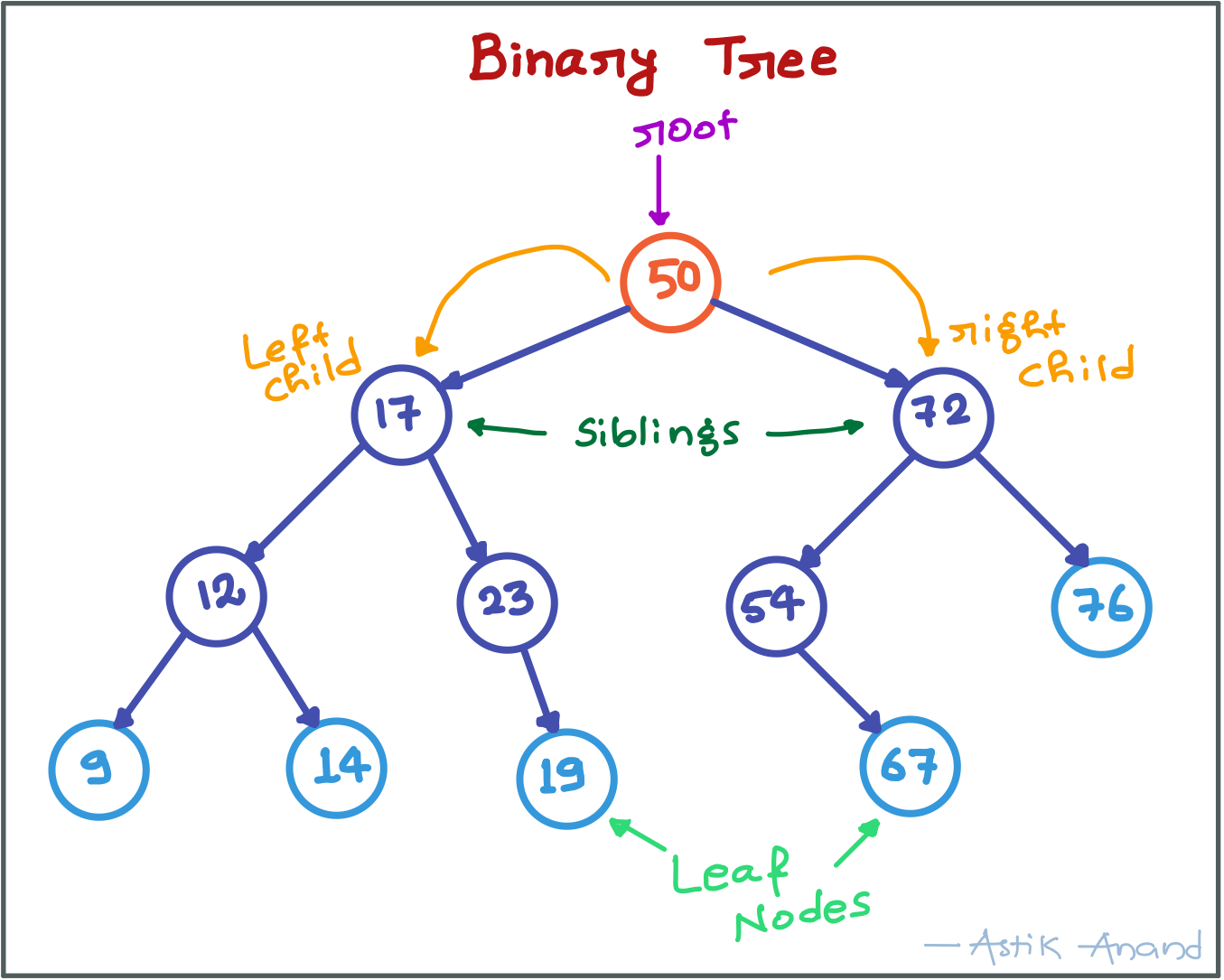
Tree Vocabulary:
- node: any element of a tree
- root: Topmost node
- children: nodes directly under a node
- parent: node directly above the node or nodes
- leaves: nodes with no children
Why trees?
- To store information that naturally forms a hierarchy. Ex: Linux filesystem
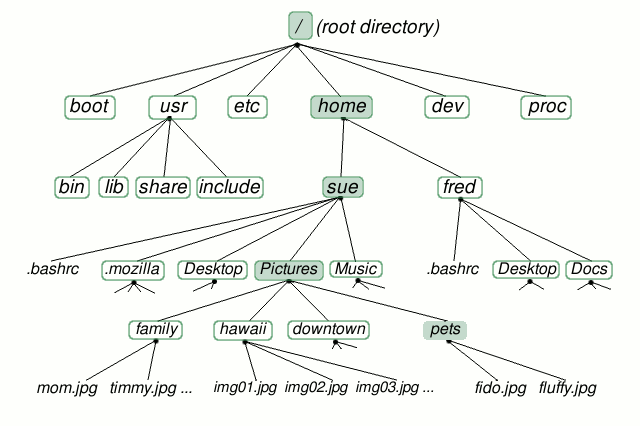
- Trees (BST) provide moderate access/search (quicker than Linked List and slower than arrays).
- Trees provide moderate insertion/deletion (quicker than Arrays and slower than Unordered Linked Lists).
- Self-balancing search trees like AVL and Red-Black trees guarantee an upper bound of O(Logn) for insertion/deletion.
- Like Linked Lists and unlike Arrays, Trees don’t have an upper limit on number of nodes as nodes are linked using pointers.
Properties of Binary Tree
- Max no. of nodes at level L: 2L-1
- Max no. of nodes in a binary tree of height “h”: 2h – 1
Types of Binary Trees
- Full Binary Tree:
- Every node has 0 or 2 children
- Leaf nodes = Internal nodes + 1
- Complete Binary Tree:
- All levels are completely filled except possibly the last level and the last level has all keys as left as possible.
- Perfect Binary Tree:
- All internal nodes have 2 children and all leaves are at same level.
- Balanced Binary Tree:
- Height of the tree: O(Log n)
- Degenerate Tree:
- Every internal node has 1 child.
Representation
- A tree whose elements have at most 2 children is called a binary tree.
- Typically named as left and right child.
Implementation:
class Node:
def __init__(self, val):
self.left = None
self.right = None
self.val = val
def print_inorder(root):
if root:
# First recur on left child
print_inorder(root.left)
# then print the data of node
print(root.val, end=" ")
# now recur on right child
print_inorder(root.right)
print("Example:- Binary Tree")
# Root
root = Node(50)
# 1st Level
root.left = Node(17)
root.right = Node(72)
# 2nd Level
root.left.left = Node(12)
root.left.right = Node(23)
root.right.left = Node(54)
root.right.right = Node(76)
# 3rd Level
root.left.left.left = Node(9)
root.left.left.right = Node(14)
root.left.right.right = Node(19)
root.right.left.right = Node(67)
# Print the tree in inorder
print_inorder(root)
print()
Output:

Applications of Binary Trees
- Manipulate hierarchical data.
- Make information easy to search (Tree traversal).
- Manipulate sorted lists of data(BST).
- As a workflow for compositing digital images for visual effects.
- Router algorithms.
- Form of a multi-stage decision-making (see business chess).
Algo-1: Tree DFS Traversals - (Inorder, Preorder, Postorder)
- Unlike linear data structures (Array, Linked List, Queues, Stacks, etc) which have only one logical way to traverse them, trees can be traversed in different ways.
- We have 3 options to traverse tree in DFS manner (Inorder, Preorder, Postorder).

Implementation
class Node:
def __init__(self, key):
self.left = None
self.right = None
self.val = key
def inorder(root):
if root:
inorder(root.left)
print(root.val, end=" ")
inorder(root.right)
def preorder(root):
if root:
print(root.val, end=" ")
preorder(root.left)
preorder(root.right)
def postorder(root):
if root:
postorder(root.left)
postorder(root.right)
print(root.val, end=" ")
# Root
root = Node(50)
# 1st Level
root.left = Node(17)
root.right = Node(72)
# 2nd Level
root.left.left = Node(12)
root.left.right = Node(23)
root.right.left = Node(54)
root.right.right = Node(76)
# 3rd Level
root.left.left.left = Node(9)
root.left.left.right = Node(14)
root.left.right.right = Node(19)
root.right.left.right = Node(67)
# Print the tree traversals
print("Inorder Traversal:")
inorder(root)
print("\n\nPreorder Traversal:")
preorder(root)
print("\n\nPostorder Traversal:")
postorder(root)
print()
Output:

Complexity:
- Time: O(n) :- worst for skewed tree
- Auxilliary Space: If we don’t consider size of stack for function calls then O(1) otherwise O(n)
Algo-2: Tree BFS Traversal - Level Order
Level order traversal of a tree is breadth first traversal for the tree.
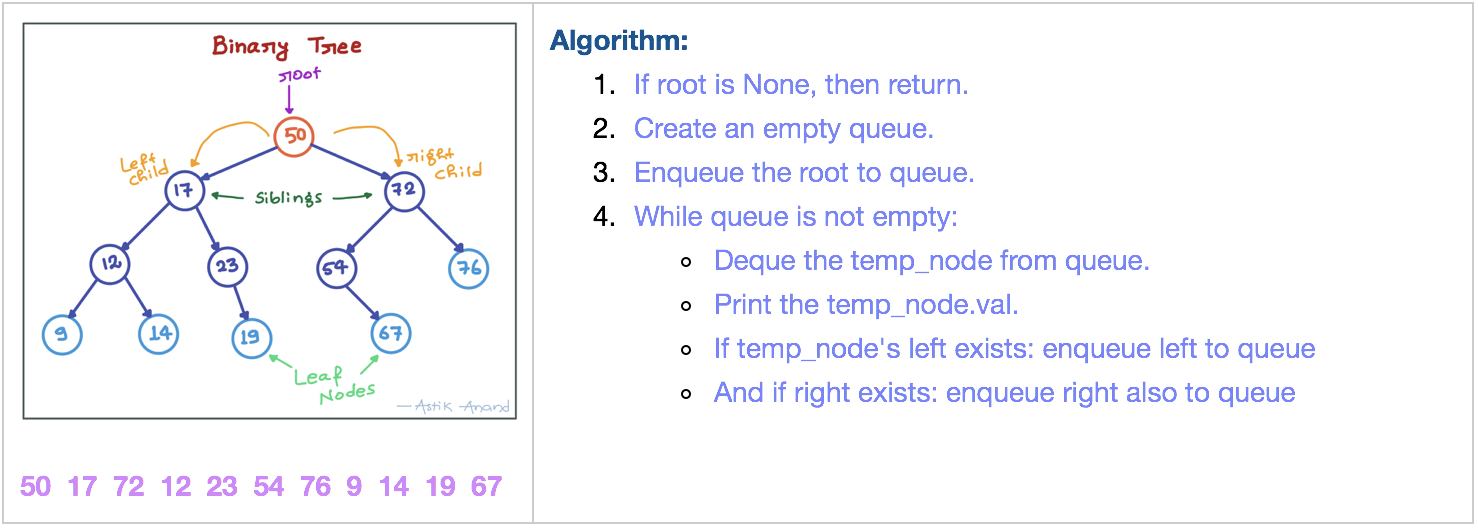
Implementation:
class Node:
def __init__(self, val):
self.left = None
self.right = None
self.val = val
def level_order_traversal(root):
# (1) If root is None, then return.
if root is None:
return
# (2) Create an empty queue.
queue = []
# (3) Enqueue root to queue.
queue.append(root)
# (4) while queue is not empty.
while(queue):
# Dequeue the temp_node from queue.
temp_node = queue.pop(0)
# Print temp_node.val
print(temp_node.val, end=" ")
# If temp_node's left exists: enqueue left to queue.
if (temp_node.left):
queue.append(temp_node.left)
# And if right exists: enqueue right also to queue.
if (temp_node.right):
queue.append(temp_node.right)
# Root
root = Node(50)
# 1st Level
root.left = Node(17)
root.right = Node(72)
# 2nd Level
root.left.left = Node(12)
root.left.right = Node(23)
root.right.left = Node(54)
root.right.right = Node(76)
# 3rd Level
root.left.left.left = Node(9)
root.left.left.right = Node(14)
root.left.right.right = Node(19)
root.right.left.right = Node(67)
print("Level Order Traversal:")
level_order_traversal(root)
print()
Output:

Complexity:
- Time : O(n) :- where n is number of nodes in the binary tree
- Auxilliary Space: O(w) where w is maximum width of Binary Tree
BFS vs DFS in Binary Tree

Why do we care?
There are many tree questions that can be solved using any of the above four traversals.
- Using DFS Traversal:
- Finding Size of Tree.
- Finding Height of Tree.
- Finding Max or Min element in a Tree.
- Diameter of Binary Tree.
- Print nodes at K distance.
- Checking if a binary tree is subtree of another binary tree.
- Ancestors of a given node.
- Using BFS Traversal:
- Maximum Width of Binary Tree.
- Left View of Tree.
- Connect Nodes at same level.
Implementation:
import sys
INT_MIN = -sys.maxsize-1
class Node:
def __init__(self, val):
self.left = None
self.right = None
self.val = val
# Computes the number of nodes in tree
def size(root):
if root is None:
return 0
else:
return (1 + size(root.left) + size(root.right))
# Computes the height of tree
def height(root):
if root is None:
return 0
else :
return (1 + max(height(root.left), height(root.right)))
# Computes the number of nodes in tree
def maximum(root):
if root is None:
return INT_MIN
else:
return max(root.val, maximum(root.left), maximum(root.right))
# Root
root = Node(50)
# 1st Level
root.left = Node(17)
root.right = Node(72)
# 2nd Level
root.left.left = Node(12)
root.left.right = Node(23)
root.right.left = Node(54)
root.right.right = Node(76)
# 3rd Level
root.left.left.left = Node(9)
root.left.left.right = Node(14)
root.left.right.right = Node(19)
root.right.left.right = Node(67)
print("Size of Tree: {}".format(size(root)))
print("Height of Tree: {}".format(height(root)))
print("Max of Tree: {}".format(maximum(root)))
Output:

Complexity:
- Time: All four traversals require O(n) time as they visit every node exactly once.
- Space:
- Extra Space required for Level Order Traversal is O(w) where w is maximum width of Binary Tree.
- In level order traversal, queue one by one stores nodes of different level.
- Extra Space required for Depth First Traversals is O(h) where h is maximum height of Binary Tree.
- In Depth First Traversals, stack (or function call stack) stores all ancestors of a node.
Important Points
- Maximum Width of a Binary Tree at depth (or height) h can be 2h where h starts from 0. So the maximum number of nodes can be at the last level.
- Worst case occurs when Binary Tree is a perfect Binary Tree with numbers of nodes like 1, 3, 7, 15, …etc. In worst case, value of 2h is Ceil(n/2).
- Height for a Balanced Binary Tree is O(Log n). Worst case occurs for skewed tree and worst case height becomes O(n).
- So in worst case extra space required is O(n) for both. But worst cases occur for different types of trees.
- It is evident from above points that extra space required for Level order traversal is likely to be more when tree is more balanced and extra space for Depth First Traversal is likely to be more when tree is less balanced.
How to pick one?
- Extra Space can be one factor.
- Depth First Traversals are typically recursive and recursive code requires function call overheads.
- The most important points is, BFS starts visiting nodes from root while DFS starts visiting nodes from leaves.
- So if our problem is to search something that is more likely to closer to root, we would prefer BFS and if the target node is close to a leaf, we would prefer DFS.
Standard Binary Trees Problems
1. Diameter of Binary Tree***
- The diameter of a tree is the number of nodes on the longest path between two leaves in the tree.
- The diagram below shows two trees each with diameter 9.
- The leaves that form the ends of a longest path are colored (note that there may be more than one path in tree of same diameter).
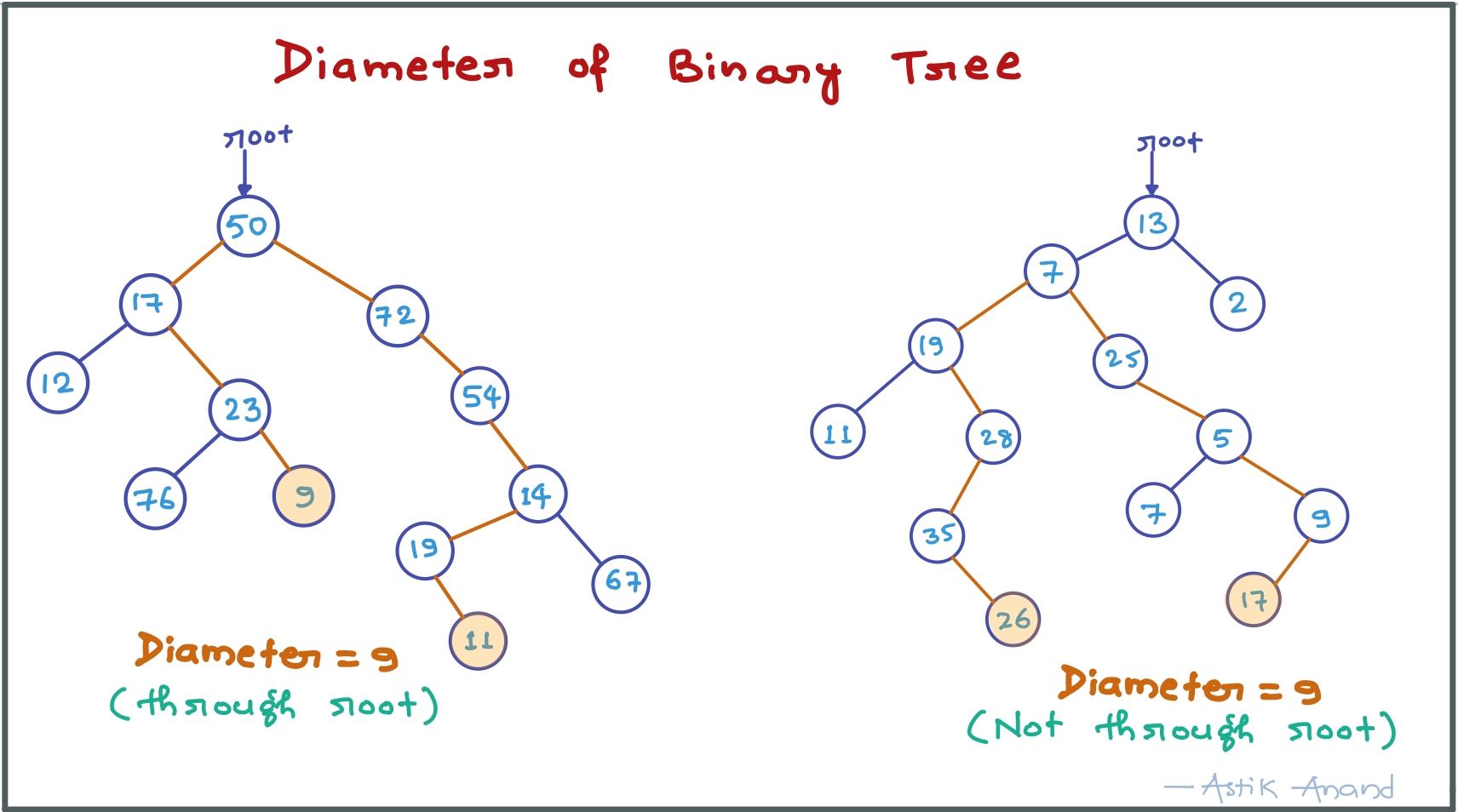
Approach:
- Diameter can be calculated by using the height function.
- Because the diameter of a tree is nothing but maximum value of (left_height +right_height +1) for each node.
- So we need to calculate this value (left_height + right_height + 1) for each node as sometimes it may not contain root also (2nd case).
- Then we need to get the max of values present at each node.
Implementation:
import sys
INT_MIN = -sys.maxsize-1
class Node:
def __init__(self, val):
self.left = None
self.right = None
self.val = val
def height(root, max_diam):
if root is None:
return 0
else :
# Get the height of left and right nodes of the current_node
left_height = height(root.left, max_diam)
right_height = height(root.right, max_diam)
# Get the diameter at current_node = 1 + left_height + right_height
# Update the max_diam[0] if current_diam > max_diam[0]
current_diam = 1 + left_height + right_height
max_diam[0] = max(max_diam[0], current_diam)
# return the height of the current_node
return (1 + max(left_height, right_height))
def diameter(root):
if root is None:
return 0
max_diam = [INT_MIN] # This will store the final answer
height(root, max_diam)
return max_diam[0]
# Root
root = Node(13)
# 1st Level
root.left = Node(7)
root.right = Node(2)
# 2nd Level
root.left.left = Node(19)
root.left.right = Node(25)
# 3rd Level
root.left.left.left = Node(11)
root.left.left.right = Node(28)
root.left.right.right = Node(5)
# 4th Level
root.left.left.right.left = Node(35)
root.left.right.right.left = Node(7)
root.left.right.right.right = Node(9)
# 5th Level
root.left.left.right.left.right = Node(26)
root.left.right.right.right.left = Node(17)
print("Diameter of Tree: {}".format(diameter(root)))
Output:

Complexity:
- Time: O(n) DFS traversal
- Auxilliary Space: O(h) where h is maximum height of Binary Tree.
2. Maximum Width of Binary Tree***
Width of a tree is maximum of widths of all levels.
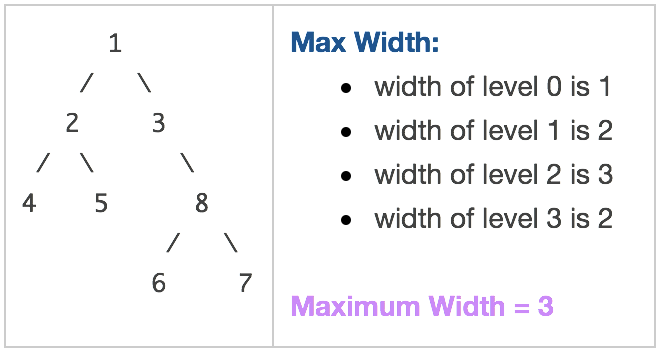
Approach:
- We will use level order traversal to solve this.
- In level order traversal, we use to dequeue one node and then enqueue it’s left and right child.
- But here a slight modification is we will dequeue all the nodes present in queue instead of one and enqueue their left and right child.
- In fact this will also give the level order traversal only but with less recursion steps.
Algorithm:
- If root is None, then return 0.
- Create an empty queue and max_width=0.
- Enqueue root to queue.
- While queue is not empty.
- Get the current_count and update max_width if it is greater.
- Dequeue all the nodes instead of one.So, while current_count > 0:
- Dequeue the temp_node from queue.
- If temp_node’s left exists: enqueue left to queue.
- And if right exists: enqueue right also to queue.
- Decrease the count by 1.
Implementation:
class Node:
def __init__(self, val):
self.left = None
self.right = None
self.val = val
def max_width_binary_tree(root):
# (1) If root is None, then return 0.
if root is None:
return 0
# (2) Create an empty queue and max_width=0.
queue = []
max_width = 0
# (3) Enqueue root to queue.
queue.append(root)
# (4) While queue is not empty.
while(queue):
# Get the current_count and update max_width if it is greater.
current_count = len(queue)
max_width = max(max_width, current_count)
# Dequeue all the nodes instead of one. So, while current_count > 0.
while(current_count > 0):
# Dequeue the temp_node from queue.
temp_node = queue.pop(0)
# If temp_node's left exists: enqueue left to queue.
if (temp_node.left):
queue.append(temp_node.left)
# And if right exists: enqueue right also to queue.
if (temp_node.right):
queue.append(temp_node.right)
current_count -= 1
return max_width
# Root
root = Node(1)
# 1st Level
root.left = Node(2)
root.right = Node(3)
# 2nd Level
root.left.left = Node(4)
root.left.right = Node(5)
root.right.right = Node(8)
# 3rd Level
root.right.right.left = Node(6)
root.right.right.right = Node(7)
print("Maximum Width = {}".format(max_width_binary_tree(root)))
Output:

Complexity:
- Time : O(n) :- BFS: Same as Level order traversal
- Auxilliary Space: O(w) where w is maximum width of Binary Tree
3. Left View of Tree***
Print all the tree elements when seen from left side.
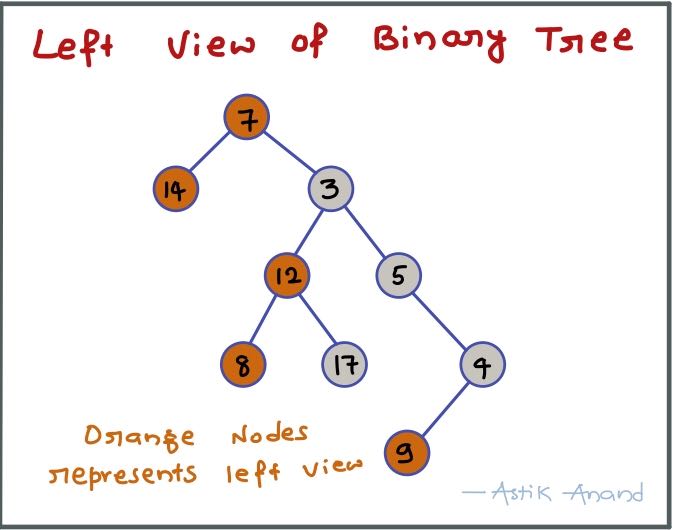
Approach:
- We can solve using level order traversal.
- Just a slight modification of maximum width problem.
- In maximum width just put a printed flag to make sure we print only the first node of that level.
Implementation:
class Node:
def __init__(self, val):
self.left = None
self.right = None
self.val = val
def left_view_binary_tree(root):
# (1) If root is None, then return.
if root is None:
return
# (2) Create an empty queue.
queue = []
# (3) Enqueue root to queue.
queue.append(root)
# (4) While queue is not empty.
while(queue):
# Get the current_count.
current_count = len(queue)
# Flag to know if first element in this level is printed.
printed = False
# Dequeue all the nodes instead of one. So, while current_count > 0.
while(current_count > 0):
# Dequeue the temp_node from queue.
temp_node = queue.pop(0)
# Print the first element in this level if it is not printed.
if(not printed):
print(temp_node.val, end=" ")
printed = True
# If temp_node's left exists: enqueue left to queue.
if (temp_node.left):
queue.append(temp_node.left)
# And if right exists: enqueue right also to queue.
if (temp_node.right):
queue.append(temp_node.right)
current_count -= 1
# Root
root = Node(4)
# 1st Level
root.left = Node(5)
root.right = Node(2)
# 2nd Level
root.right.left = Node(3)
root.right.right = Node(1)
# 3rd Level
root.right.left.left = Node(6)
root.right.left.right = Node(7)
print("Left View of Binary Tree: ")
left_view_binary_tree(root)
print()
Output:

Complexity:
- Time : O(n) :- Same as maximum width problem
- Auxilliary Space: O(w) where w is maximum width of Binary Tree
4. Print Nodes at K distance from Root
Given a root of a tree, and an integer k. Print all the nodes which are at k distance from root.

Algorithm:
- If distance is 0 : print the root.
- Else call the recursive function for root.left and root.left with distance-1.
Implementation:
class Node:
def __init__(self, key):
self.left = None
self.right = None
self.val = key
def print_nodes_at_k_distance(root, k):
if root is None:
return
if k==0:
print(root.val, end=" ")
else:
print_nodes_at_k_distance(root.left, k-1)
print_nodes_at_k_distance(root.right, k-1)
# Root
root = Node(50)
# 1st Level
root.left = Node(17)
root.right = Node(72)
# 2nd Level
root.left.left = Node(12)
root.left.right = Node(23)
root.right.left = Node(54)
root.right.right = Node(76)
# 3rd Level
root.left.left.left = Node(9)
root.left.left.right = Node(14)
root.left.right.right = Node(19)
root.right.left.right = Node(67)
print("Nodes at distance of k=2:")
print_nodes_at_k_distance(root, 2)
print()
Output:

Complexity:
- Time: O(n) DFS traversal
- Auxilliary Space: O(h) where h is maximum height of Binary Tree.
5. Check if Binary Tree is Sub-tree of another Binary Tree***
Problem:
- Given two binary trees, check if the first tree is subtree of the second one.
- A subtree of a tree T is a tree S consisting of a node in T and all of its descendants in T.
- The subtree corresponding to the root node is the entire tree; the subtree corresponding to any other node is called a proper subtree.
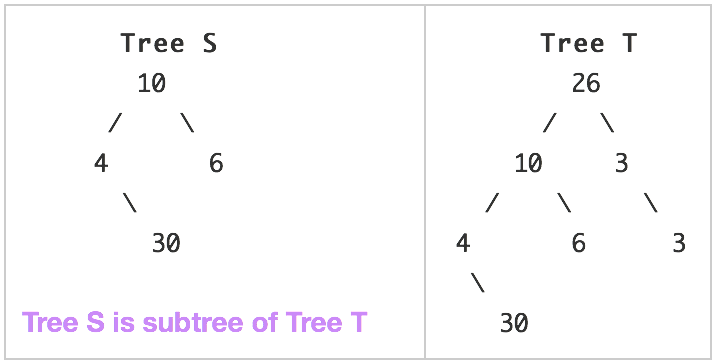
Approach:
- Write a identical function to check if 2 trees are identical.
- Traverse the tree T in preorder fashion.
- For every visited node in the traversal, check if the subtree rooted with this node is identical to S.
Algorithm:
- are_identical(root1, root2):
- If both are NULL, then True.
- If one is None and other not None, then False.
- return True if the val of both roots is same and left subtree and right subtree are are_identical else False.
- is_subtree(S, T):
- If S is None, always subtree.
- If S is not None and T is none, not a subtree.
- If both are identical return True.
- Check if S is subtree of T.left or T.right.
Implementation:
class Node:
def __init__(self, key):
self.left = None
self.right = None
self.val = key
def are_identical(root1, root2):
# If both are NULL, then True.
if root1 is None and root2 is None:
return True
# If one is None and other not None, then False.
if root1 is None or root2 is None:
return False
# Check if the val of both roots is same and left subtree and right subtree are are_identical.
return (root1.val==root2.val and
are_identical(root1.left, root2.left) and
are_identical(root1.right, root2.right))
def is_subtree(S, T):
# If S is None, always subtree.
if S is None:
return True
# If S is not None and T is none, not a subtree.
if T is None:
return False
# If both are identical return True.
if are_identical(S, T):
return True
else:
# Check if S is subtree of T.left or T.right
return is_subtree(S, T.left) or is_subtree(S, T.right)
# Tree T
T = Node(26)
T.left = Node(10)
T.right = Node(3)
T.left.left = Node(4)
T.left.right = Node(6)
T.right.right = Node(3)
T.left.left.right = Node(30)
# Tree S
S = Node(10)
S.left = Node(4)
S.right = Node(6)
S.left.right = Node(30)
print("Example-1: Is Tree S subtree of Tree T ?: {}".format(is_subtree(S, T)))
# Tree S
S = Node(4)
S.right = Node(30)
print("Example-2: Is Tree S subtree of Tree T ?: {}".format(is_subtree(S, T)))
# Tree S
S = Node(4)
S.right = Node(15)
print("Example-3: Is Tree S subtree of Tree T ?: {}".format(is_subtree(S, T)))
Output:

Complexity:
- Time: O(n) DFS traversal
- Auxilliary Space: O(h) where h is maximum height of Binary Tree.
6. Connect Nodes at Same Level***
Problem:
Write a function to connect all the adjacent nodes at the same level in a binary tree.
Initially, all the nextRight pointers point to garbage values, the function should set these pointers to point next right for each node.
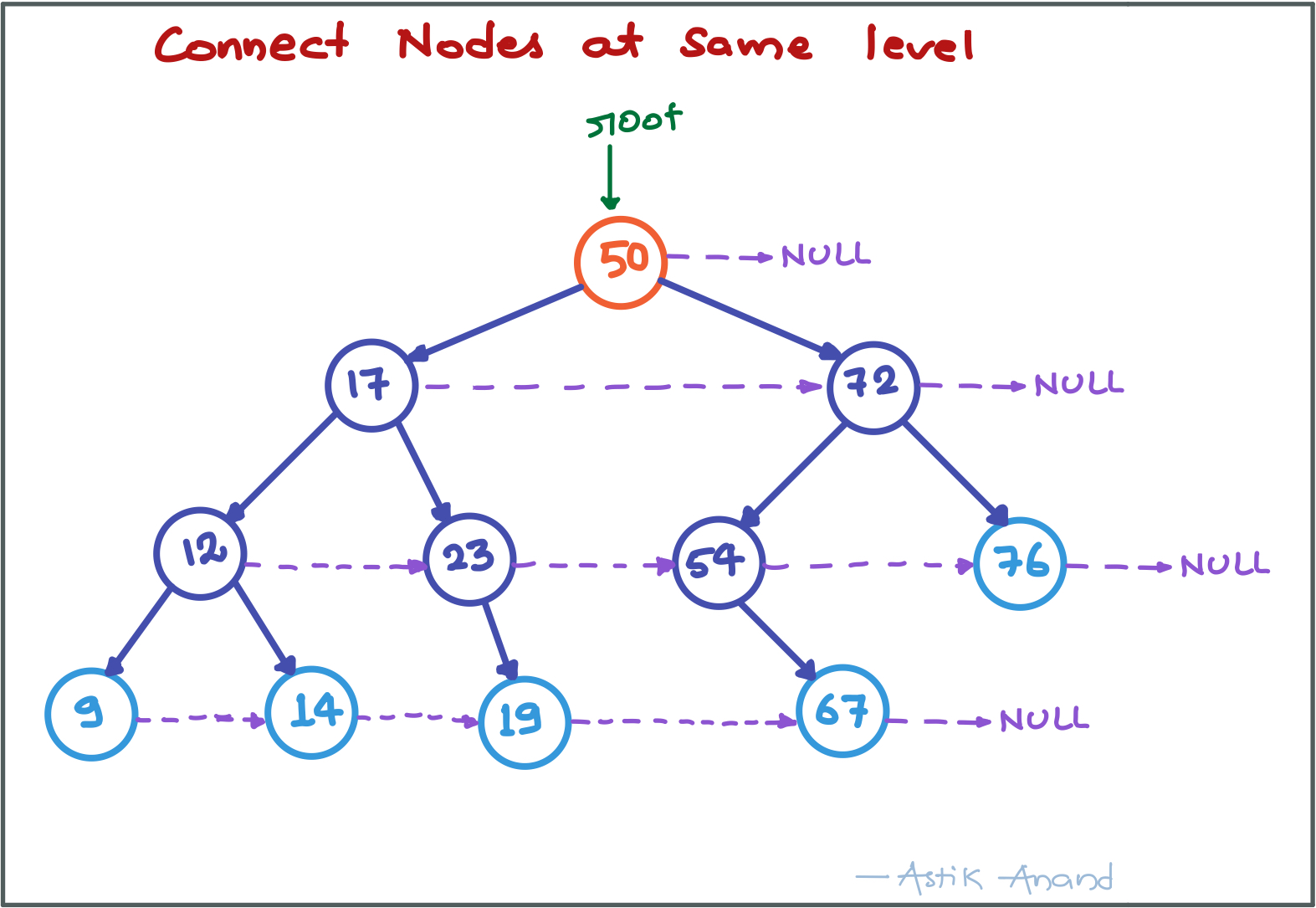
Approach:
- Just do a level order traversal similar to max_width or left_view problem.
- While taking out node from queue just set the nextright as the node in front of queue.
- Set the next_right and consider that at every level the last element will not point to any other node as the front will be empty.
Implementation:
class Node:
def __init__(self, val):
self.val = val
self.left = None
self.right = None
self.nextright = None
def connect_nodes_at_same_level(root):
# (1) If root is None, then return.
if root is None:
return
# (2) Create an empty queue.
queue = []
# (3) Enqueue root to queue.
queue.append(root)
# (4) While queue is not empty.
while(queue):
# Get the current_count.
current_count = len(queue)
# Dequeue all the nodes instead of one. So, while current_count > 0.
while(current_count > 0):
# Dequeue the temp_node from queue.
temp_node = queue.pop(0)
print("{}--->".format(temp_node.val), end="")
# Set the next_right and consider that at every level
# the last element will not point to any other node as the front will be empty.
if(current_count > 1):
temp_node.nextright = queue[0]
else:
temp_node.nextright = None
print("None")
# If temp_node's left exists: enqueue left to queue.
if (temp_node.left):
queue.append(temp_node.left)
# And if right exists: enqueue right also to queue.
if (temp_node.right):
queue.append(temp_node.right)
current_count -= 1
# Root
root = Node(50)
# 1st Level
root.left = Node(17)
root.right = Node(72)
# 2nd Level
root.left.left = Node(12)
root.left.right = Node(23)
root.right.left = Node(54)
root.right.right = Node(76)
# 3rd Level
root.left.left.left = Node(9)
root.left.left.right = Node(14)
root.left.right.right = Node(19)
root.right.left.right = Node(67)
# Call Function
connect_nodes_at_same_level(root)
Output:

Complexity:
- Time : O(n) :- Same as maximum_width or left_view problem.
- Auxilliary Space: O(w) where w is maximum width of Binary Tree.
7. Ancestors of a Given Node in Binary Tree***
Problem:
Given a Binary Tree and a key, write a function that prints all the ancestors of the key in the given binary tree.
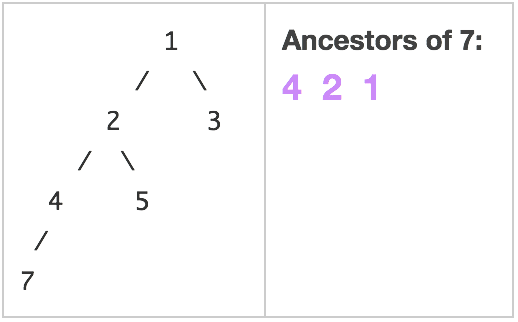
Algorithm:
- If root is None return False.
- If root.val is given_node then return True.
- Print the root.data if any of root.left or root.right contains the given_node and return True.
- If given_node not in tree, return False
Implementation:
class Node:
def __init__(self, key):
self.left = None
self.right = None
self.val = key
def print_ancestors(root, k):
# If root is None return False.
if root is None:
return False
# If root.val is given_node then return True.
if root.val == k:
return True
# Print the root.data if any of root.left or root.right contains the given_node and return True.
if(print_ancestors(root.left, k) or print_ancestors(root.right, k)):
print(root.val, end=" ")
return True
# If given_node not in tree, return False
return False
# Root
root = Node(1)
root.left = Node(2)
root.right = Node(3)
root.left.left = Node(4)
root.left.right = Node(5)
root.left.left.left = Node(7)
print("Ancestors of given_node k=7:")
print_ancestors(root, 7)
print()
print("Ancestors of given_node k=3:")
print_ancestors(root, 3)
print()

Complexity:
- Time: O(n) DFS traversal
- Auxilliary Space: O(h) where h is maximum height of Binary Tree.
8. Check if Binary Tree is Balanced***
Problem:
Check if bianry tree is height balanced by considering a height-balancing scheme where following conditions should be checked to determine if a binary tree is balanced.
- An empty tree is always height-balanced.
- A non-empty binary tree T is balanced if:
- Left subtree of T is balanced
- Right subtree of T is balanced
- The difference between heights of left subtree and right subtree is not more than 1.
- This height-balancing scheme is used in AVL trees.
Approach-1: Brute-Force:
- Get the height of left subtree and right subtree and check if difference is 1.
- Also check if left subtree and right subtree is balanced.
- Time Complexity: O(n2): Worst case occurs in case of skewed tree.
Implementation-Approach-1:
def height(root):
if root is None:
return 0
return max(height(root.left), height(root.right)) + 1
# function to check if tree is height-balanced or not
def isBalanced(root):
if root is None:
return True
# left and right subtree height
lh = height(root.left)
rh = height(root.right)
# allowed values for (lh - rh) are 1, -1, 0
if (abs(lh-rh) <= 1) and isBalanced(root.left) and isBalanced( root.right):
return True
# if we reach here means tree is not height-balanced tree
return False
Approach-2: Optimized:
- Above implementation can be optimized by calculating the height in the same recursion rather than calling a height() function separately.
- Time complexity: O(n)
Implementation-Approach-2:
class Node:
def __init__(self, data):
self.data = data
self.left = self.right = None
class Height:
def __init__(self):
self.height = 0
def isBalanced(root, height):
# lh and rh to store height of left and right subtree
lh = Height()
rh = Height()
if root is None:
return True
# l and r are used to check if left and right subtree are balanced
l = isBalanced(root.left, lh)
r = isBalanced(root.right, rh)
# Update height
height.height = max(lh.height, rh.height) + 1
if abs(lh.height-rh.height) <= 1 and l and r:
return True
# if we reach here then the tree is not balanced
return False
root = Node(1)
root.left = Node(2)
root.right = Node(3)
root.left.left = Node(4)
root.left.right = Node(5)
root.right.left = Node(6)
root.left.left.left = Node(7)
if isBalanced(root, Height()):
print('Tree is balanced')
else:
print('Tree is not balanced')
11. Serialize and Deserialize Binary Tree
Serialization & Deserialization
It is the process of converting a data structure or object into a sequence of bits so that it can be stored in a file or memory buffer, or transmitted across a network connection link to be reconstructed (deserialized) later in the same or another computer environment.
Problem:
Design an algorithm to serialize and deserialize a binary tree. There is no restriction on how your serialization/deserialization algorithm should work. You just need to ensure that a binary tree can be serialized to a string and this string can be deserialized to the original tree structure.
Approach: Use DFS on Binary Tree
A simple solution is to store both Inorder and Preorder traversals. This solution requires requires space twice the size of Binary Tree. We can save space by storing Preorder traversal and a marker for NULL pointers.
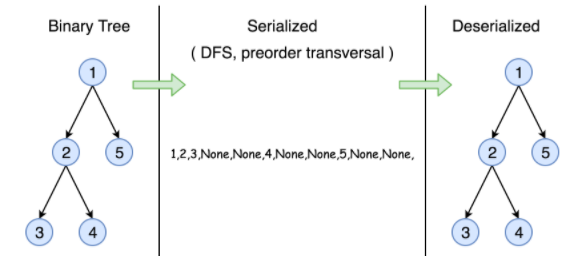
Other Examples:
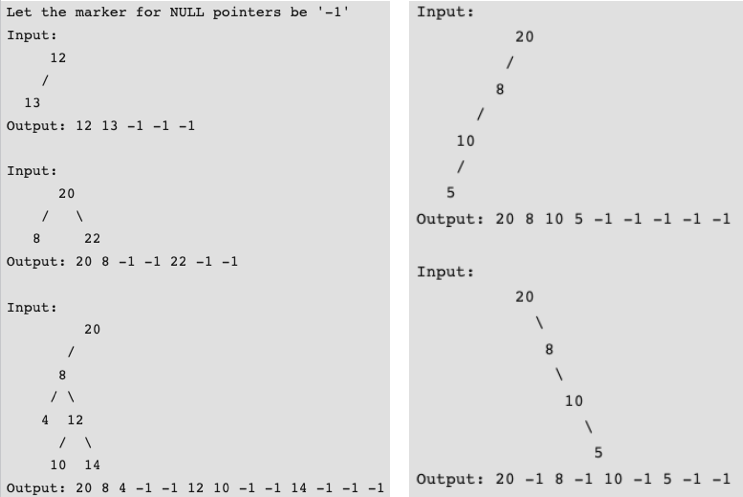
Implementation:
class TreeNode(object):
def __init__(self, x):
self.val = x
self.left = None
self.right = None
class Codec:
def serialize(self, root):
serialized_btree = []
self._modified_pre_order(root, serialized_btree)
return ",".join(serialized_btree)
def _modified_pre_order(self, root, serialized_btree):
if root:
serialized_btree.append(str(root.val))
self._modified_pre_order(root.left, serialized_btree)
self._modified_pre_order(root.right, serialized_btree)
else:
serialized_btree.append("#")
def deserialize(self, data):
nodes_list = data.split(",")
nodes_list.reverse()
return self._build_tree(nodes_list)
def _build_tree(self, nodes_list):
if not nodes_list:
return
key = nodes_list.pop()
if key != "#":
root = TreeNode(int(key))
root.left = self._build_tree(nodes_list)
root.right = self._build_tree(nodes_list)
return root
def print_tree(root):
if root:
print(root.val, end=" ")
print_tree(root.left)
print_tree(root.right)
# Your Codec object will be instantiated and called as such:
# 1
# / \
# 2 3
# / \
# 4 5
# / \
# 7 6
root = TreeNode(1)
root.left = TreeNode(2)
root.right = TreeNode(3)
root.right.left = TreeNode(4)
root.right.right = TreeNode(5)
root.right.left.left = TreeNode(7)
root.right.left.right = TreeNode(6)
codec = Codec()
print_tree(codec.deserialize(codec.serialize(root)))
print()
# 20
# /
# 8
# / \
# 4 12
# / \
# 10 14
root = TreeNode(20)
root.left = TreeNode(8)
root.left.left = TreeNode(4)
root.left.right = TreeNode(12)
root.left.right.left = TreeNode(10)
root.left.right.right = TreeNode(14)
codec = Codec()
print_tree(codec.deserialize(codec.serialize(root)))
print()
Output:

Complexity Analysis:
- Time complexity: O(N) In both serialization and deserialization functions, we visit each node exactly once, thus the time complexity is O(N), where N is the number of nodes, i.e. the size of tree.
- Space complexity: O(N) In both serialization and deserialization functions, we keep the entire tree, either at the beginning or at the end, therefore, the space complexity is O(N).
← Previous: Matrix Next: Binary Serach Tree →